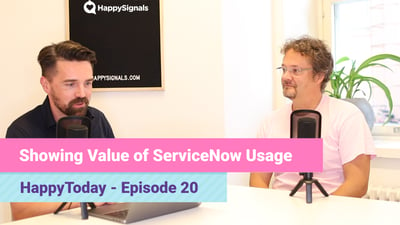With this tool and these discussions, we are on the same side of the table with the customer.
Minna Nousiainen, SVP, End User Services at Enfo.
Where did Enfo begin its journey?
Enfo, a major Managed Service Provider in the Nordics, started their journey by beginning to measure end-user satisfaction in 2012 when they started using ServiceNow, where they were using their own ticketing survey tool.
In April 2018, Enfo decided to start using HappySignals. This led them to a "whole new level" of collecting feedback and in-depth data on what is going on with their end-users. This was their first step into becoming a modern IT Service Provider, due to their previous in house tool not being sufficient when coming to measure service experience.
Minna Nousiainen claims that HappySignals' tool was easy to deploy and led to a comprehensive view into what is going on with their customers. This involved beginning to measure customer satisfaction on 3 different levels, as well as connecting measurement to their business goals.
Culture. Culture. Culture.
Like most Managed Service Providers and IT Services, Enfo faces the uphill battle of changing their culture to be focused on measuring end-user experience. Enfo's culture was a heavily tech-focused company, so changing this to focus on end-user/customer satisfaction was, and still at times, a challenge.
However, this is all part of the journey a company must go through to truly integrate employee experience and in Enfo's case, to become a modern IT Service Provider.
Now, Enfo have tried to cover all of their teams, processes and even vendors with HappySignals tooling. As well as this, Enfo makes the data available to their Service Desk agents and to their customers.
By offering open transparency between all parties, will lead you well on your journey to truly embrace employee experience.
How does Enfo continue to enhance End-user Experience?
Quarterly forums have been created in order to collect and review data from all measurements and processes. This is an internal forum group, consisting of 4 people, which is lead by their Sales Director. Enfo creates decisions based on the data that has been recorded for that quarter.
The process of handling all negative feedbacks (scores from 0 - 6), has also been taken into careful consideration. When receiving negative feedback, the responsibility is given to the Service Desk agent to implement the need for adjustment or change, therefore minor adjustments are made daily, keeping employee experience at the heart of everything they do.
Segmenting and separating different areas for measurement is also something Enfo has begun to do, for example by separating IT Incidents and Requests. This may have negatively impacted their Happiness Score™, but it has given them great insight into which areas are suffering and where there is room for improvement.
In order to become a modern IT Service Provider, Enfo continues to search for many different areas where they can improve. Even though they are beginning to make great improvements with their experience data and their customers are satisfied, Enfo are not. They will continuously measure and want to continuously improve their customers experience.
This in itself is great advice for Managed Service Providers looking to truly embrace end-user experience.
What has surprised Enfo about HappySignals?
From the Happiness Index, Minna admits that Enfo has been able to gain insight into the workload of their Service Desk agents. This means they can also see what is going on with their end-users work load as well.
From collecting data over time, they have been able to predict trends and follow increased work volumes, making it easier to adjust their operational changes in order to handle increase workloads that the customer may be facing.
What's in store for the future at Enfo?
Now Enfo has fully implemented HappySignals tool, Minna wants to "use the data more comprehensively" across more areas and services to meet more end-users needs.
Response rate from end-users is also something they wish to improve, to increase higher volumes of valuable data. Enfo wants to give back to their end-users for giving this constructive insights.
With higher volumes, leads to more responses, ending with more ways to improve experience.



